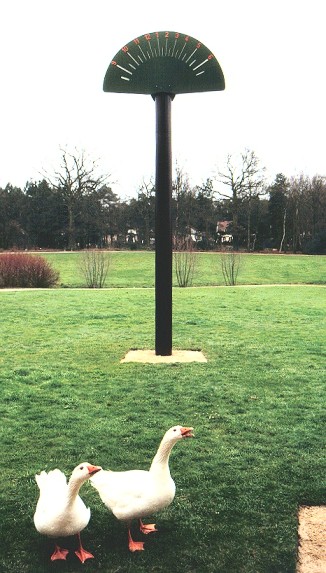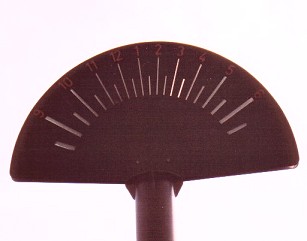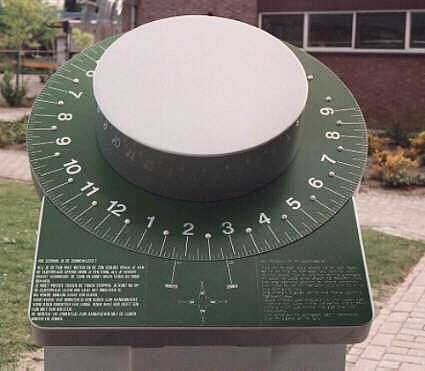
Sundial Park Genk
11. Sonius' Tree

Again a unique, novel design, and an impressive construction. And how appropriate, to have a tree-shaped sundial in the park! The 'crown' of the tree reaches 6 m (20 ft) up into the sky. In the front and back plane of the crown, pairs of slits have been made ('front' and 'back' as seen from the north). When the sun lines up with a pair of slits, the light falls through. A translucent plate covering the front slits from the inside, is then lit, so that the dial can be read from a broad angle.
The pairs of slits each span either a full-hour or a half-hour plane. This dial thus is another example of a shadow plane or hour plane dial, in addition to the adjacent large shadow plane dial (nr. 10). An explanation of the shadow plane principle can also be found there.
The dial reads summertime (East European Time, EET*); that's why the slits for 13:30 hr are approximately vertical. In other words: it's about noon local time then. The page on the polyhedron dial (nr. 4) has more on hour types.
The sundial has been designed by Jan Kragten (Netherlands) and Fer de Vries (Secretary of the Dutch Sundial Society), after an idea of Gerard Sonius (Netherlands).
My comments:
 How to read the dial
How to read the dial
The dial can be read with quite some precision (when the sun shines). In the example here, the slits for 3:00 and 3:30 are both being lit. If both were equally bright, the reading would be around 3:15. Here, the latter slit is somewhat brighter, so the best estimate is about 3:20 p.m. EET*. The poor contrast in the picture is a consequence of the backlight situation; sorry! (The photographers for the brochure and the website of the Flemish Sundial Society did better in that respect: they took pictures from the south side...)
Terminology
The English name 'shadow plane sundial' is not completely adequate, as it does not recognize the possibility that the plane is made up of sunlight instead of shadow, as is the case here. In Dutch the term 'hour plane sundial' is used, which does not recognize the possibility of half-hour planes, as - again - is the case here, or perhaps quarter-hour planes.
Relationship between hour planes
As said before, the hour planes can be positioned any way the designer might prefer. In this case the planes, formed by the pairs of slits, are arranged in such a way that they intersect each other in one single line. That line necessarily is a pole-style, and the slits on each side are fragments of the hour lines of the corresponding vertical dial, in this case extended upward from the insertion point of the imaginary pole-style.
Gerard Sonius
Gerard Sonius (Netherlands) was a very imaginative and unconventional gnomonist. His major achievement is a sundial for the blind that was installed in 1991 in the Bartimeüs Institute in Zeist (Netherlands). A large circular disk, which can be rotated by the visitor, is oriented in the equatorial plane. When an optic sensor 'sees' the sun, the instrument beeps and provides also a tactile signal. The time (both standard and summer time) can be read in braille as well as in 'normal' text.
